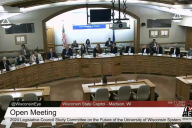You have /5 articles left.
Sign up for a free account or log in.
So, today's the day after P-Day. As in "Plan Day." As in "Climate Action Plan due date."
For charter signatories of the Presidents Climate Commitment, yesterday was the nominal deadline for getting a school's initial Climate Action Plan -- a first cut at a road map to achieving carbon (not really "climate") neutrality. As I've indicated before, this is a task perhaps one size bigger than the campus itself (significant for a small school, big for a mid-sized school, huge for a big school, etc.). Not only does it require a significant effort on the part of planners and sustainability folk, but it requires active involvement from faculty, academic and operational leadership (not just grunts), and whoever controls the budget. Getting all these planets to align may get easier over time, but the first time a school tries, it's pretty hard.
So, as a group, how are the charter signatories doing? On the whole, pretty good.
I did a quick visual count at the PCC website, and here's how it looked to me. (Be aware that the actual numbers can change rapidly.)
First, I counted 382 charter signatories. These are the schools who signed on early, and the only ones who were scheduled to publish their plans yesterday. Of these, 137 have been granted extensions of time, leaving 245 whose reports were still expected. Of those 245, only 79 reports were shown as received, but things may not be as bad as that sounds. Before a school files its plan, it's expected to file an initial report and a greenhouse gas (GHG) inventory. 107 charter signatories have filed their reports and GHG inventories, but haven't yet filed an action plan -- there's a reasonable case for saying that a majority of these are probably one step away from filing.
First, a number of the schools who have yet to file are campuses of state systems, none of which have filed. I'm presuming that there's some sort of internal administrative/budget hurdle which has to be jumped before filing can occur; very possibly the plans have been written but lack one or two approvals before they can be published.
Second, another group of schools is located in Los Angeles. I'm guessing that if I were a sustainability/facilities/energy person at a university in or near LA, I'd have had bigger things on my plate than filing any report. (250 square miles burned! 250 SQUARE MILES!!)
And third, filing a Climate Action Plan online turned out to be a little more complicated than some of us had expected. The "file a plan" website seemed to function appropriately, but it made a lot of assumptions about how the plan would be structured, and presented, and formatted. (Not that the assumptions were particularly unreasonably, nor that they weren't communicated ahead of time. But planning is a complex activity, subject to a lot of methodological and formatting variation, so any expectations about what "all those schools" are going to come up with is likely to be problematic.) Some schools may have gone online to file, only to find that they needed to do a little recalculating or reformatting before they could submit their data.
(By the way, if your school went through some variant on any of the above, please let the rest of us know. Post it here as a comment, or email me, or tell your friendly local AASHE rep. This is a learning experience for all of us.)
So, on a best-guess level, let's say that 90% of the schools who have been granted extensions will eventually file. And maybe 80% of those whose GHG inventories were reported, but whose action plans aren't yet public. And none of the rest.
What does that come out to? Of 382 charter signatories, I'm guessing 79 (already submitted) + 123 (90% of 137) + 86 (80% of 107) = 288. That's about 3 out of 4. A solid C where I come from. (Apply your own grade inflation algorithm here.)
Of course, my guesses may turn out to be too conservative. (Actually, I hope they do.) It could well go up from there. And, realistically, the starting number probably shouldn't be 382. Of those schools whose presidents signed on early, 22 never took (or, at least, never reported taking) any tangible action. It's like the prez went on shore leave a couple of years back, got a sustainability tattoo (it seemed like a good idea at the time), then returned to campus to find that nobody else was smiling. One of those things that nobody can entirely forget but, even when pressed, nobody on campus is going to 'fess up to remembering, either. Take those 22 schools out of the equation, and even my conservative projection turns into a borderline B. (Again, your mileage may vary.)
But, for a complex undertaking in an even more complex environment, and the first time any of us have ever tried to do anything quite like this, that's pretty darn good.





